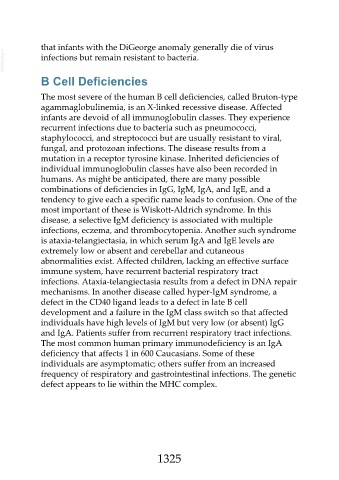Page 1325 - Veterinary Immunology, 10th Edition
P. 1325
that infants with the DiGeorge anomaly generally die of virus
VetBooks.ir infections but remain resistant to bacteria.
B Cell Deficiencies
The most severe of the human B cell deficiencies, called Bruton-type
agammaglobulinemia, is an X-linked recessive disease. Affected
infants are devoid of all immunoglobulin classes. They experience
recurrent infections due to bacteria such as pneumococci,
staphylococci, and streptococci but are usually resistant to viral,
fungal, and protozoan infections. The disease results from a
mutation in a receptor tyrosine kinase. Inherited deficiencies of
individual immunoglobulin classes have also been recorded in
humans. As might be anticipated, there are many possible
combinations of deficiencies in IgG, IgM, IgA, and IgE, and a
tendency to give each a specific name leads to confusion. One of the
most important of these is Wiskott-Aldrich syndrome. In this
disease, a selective IgM deficiency is associated with multiple
infections, eczema, and thrombocytopenia. Another such syndrome
is ataxia-telangiectasia, in which serum IgA and IgE levels are
extremely low or absent and cerebellar and cutaneous
abnormalities exist. Affected children, lacking an effective surface
immune system, have recurrent bacterial respiratory tract
infections. Ataxia-telangiectasia results from a defect in DNA repair
mechanisms. In another disease called hyper-IgM syndrome, a
defect in the CD40 ligand leads to a defect in late B cell
development and a failure in the IgM class switch so that affected
individuals have high levels of IgM but very low (or absent) IgG
and IgA. Patients suffer from recurrent respiratory tract infections.
The most common human primary immunodeficiency is an IgA
deficiency that affects 1 in 600 Caucasians. Some of these
individuals are asymptomatic; others suffer from an increased
frequency of respiratory and gastrointestinal infections. The genetic
defect appears to lie within the MHC complex.
1325

